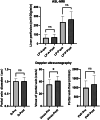Short-term repeatability and postprandial effect assessment of liver perfusion quantification in healthy subjects using arterial spin labeling MRI
- PMID: 40764470
- PMCID: PMC12325835
- DOI: 10.1186/s13244-025-02051-0
Short-term repeatability and postprandial effect assessment of liver perfusion quantification in healthy subjects using arterial spin labeling MRI
Abstract
Objectives: To assess the stability of liver perfusion quantification using arterial spin labeling MRI (ASL-MRI) in healthy subjects.
Materials and methods: The arterial and portal venous liver perfusion were measured with two pseudo-continuous ASL acquisitions at a 3.0-Tesla MRI system. To assess the short-term repeatability of ASL-MRI, twelve healthy subjects underwent three consecutive ASL examinations in the fasting state. Following meal ingestion, the postprandial liver perfusion was measured. Changes in liver perfusion measured by ASL before and after meal ingestion, and their correspondence with portal vein hemodynamic variations assessed by Doppler ultrasonography (US), were analyzed to evaluate the stability of ASL in detecting postprandial perfusion alterations.
Results: The arterial and portal venous liver perfusions in healthy volunteers under the fasting condition were 59.3 ± 17.8 and 237.6 ± 71.9 mL/100 g/min, respectively. Both the arterial and portal venous liver perfusion results demonstrated excellent short-term repeatability (ICCs, 0.97, 0.96; CVs, 6.43%, 6.17%). Furthermore, Bland-Altman plots indicated a high degree of consistency between every two pairs of the three measurements. Compared to the fasting state, the relative changes in postprandial portal venous perfusion measured by ASL-MRI demonstrated a moderate correlation (Pearson correlation coefficient r = 0.66) and good agreement (with all data points in the Bland-Altman plot falling within the limits of agreement) with those in portal vein blood flow measured by Doppler US.
Conclusion: ASL-MRI enables reliable quantification of liver perfusion in healthy individuals under both constant conditions and altered perfusion state induced by a meal. It holds great promise as a non-invasive tool for diagnosing liver disease.
Critical relevance statement: The short-term repeatability and postprandial effect of liver perfusion quantification using arterial spin labeling MRI in healthy subjects both exhibited excellent performance, indicating the potential of this technique as a non-invasive tool for diagnosing liver diseases.
Key points: Arterial spin labeling (ASL)-MRI enables reliable liver perfusion quantification in healthy individuals. ASL-MRI showed great short-term repeatability for liver perfusion measurement in the fasting state. ASL-MRI and US showed a moderate correlation in measuring postprandial portal venous hemodynamics change.
Keywords: Arterial spin labeling; Liver perfusion; Magnetic resonance imaging; Postprandial effect; Repeatability.
© 2025. The Author(s).
Conflict of interest statement
Declarations. Ethics approval and consent to participate: This study received approval from the Ethics Committee of Beijing Friendship Hospital affiliated with Capital Medical University, with the approval number 2024-P2-069. Consent for publication: Written informed consent for publication was obtained from all participants. Competing interests: J.Z., Y.S. and B.K. are affiliated with Siemens Healthineers. The remaining authors declare that they have no competing interests.
Figures






Similar articles
-
Repeatability and Reproducibility of Pseudocontinuous Arterial Spin-Labeling-Measured Brain Perfusion in Healthy Volunteers and Patients with Glioblastoma.AJNR Am J Neuroradiol. 2025 May 2;46(5):973-982. doi: 10.3174/ajnr.A8551. AJNR Am J Neuroradiol. 2025. PMID: 39443151
-
Voxel-Based Specific Regional Analysis System for Alzheimer's Disease and Arterial Spin Labeling in Brain Magnetic Resonance Imaging: A Comparative Study.Curr Med Imaging. 2025 Jul 10. doi: 10.2174/0115734056337828250526070304. Online ahead of print. Curr Med Imaging. 2025. PMID: 40653835
-
High-Fidelity MRI Assessment of Cerebral Perfusion in Healthy Neonates Less Than 1 Week of Age.J Magn Reson Imaging. 2025 Sep;62(3):737-748. doi: 10.1002/jmri.29740. Epub 2025 Feb 13. J Magn Reson Imaging. 2025. PMID: 39945520
-
Comparison of Dynamic Susceptibility Contrast and Arterial Spin Labeling MRI Perfusion in the Assessment of Stroke and Steno-Occlusive Disease: A Systematic Review and Meta-Analysis.Diagnostics (Basel). 2025 Jun 21;15(13):1578. doi: 10.3390/diagnostics15131578. Diagnostics (Basel). 2025. PMID: 40647577 Free PMC article. Review.
-
Arterial spin labeling MRI in patients undergoing carotid artery revascularization: a systematic review of the hemodynamic changes and clinical implications.Eur Radiol. 2025 Aug 6. doi: 10.1007/s00330-025-11885-7. Online ahead of print. Eur Radiol. 2025. PMID: 40767871 Review.
References
-
- Turcotte S (2017) Liver blood flow: physiology, measurement, and clinical relevance. In Jarnagin WR (ed.). Blumgart’s Surgery of the Liver, Biliary Tract and Pancreas. 2-volume set (sixth edition). Elsevier, Philadelphia. pp. 74–86
-
- Pandharipande PV, Krinsky GA, Rusinek H, Lee VS (2005) Perfusion imaging of the liver: current challenges and future goals. Radiology 234:661–673 - PubMed
-
- Ronot M, Leporq B, Van Beers BE, Vilgrain V (2020) CT and MR perfusion techniques to assess diffuse liver disease. Abdom Radiol (NY) 45:3496–3506 - PubMed
-
- Leen E, Goldberg JA, Angerson WJ, McArdle CS (2000) Potential role of Doppler perfusion index in selection of patients with colorectal cancer for adjuvant chemotherapy. Lancet 355:34–37 - PubMed
-
- Oppo K, Leen E, Angerson WJ, Cooke TG, Macardle CS (1998) Doppler perfusion index: an interobserver and intraobserver reproducibility study. Radiology 208:453–457 - PubMed
Grants and funding
LinkOut - more resources
Full Text Sources

